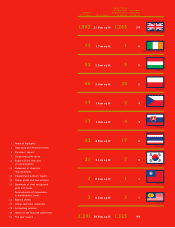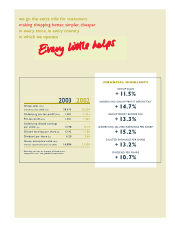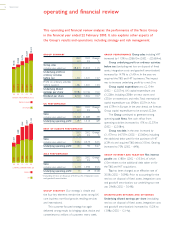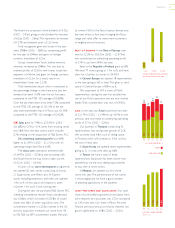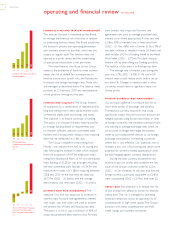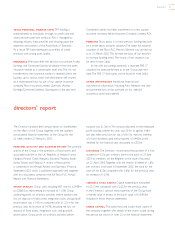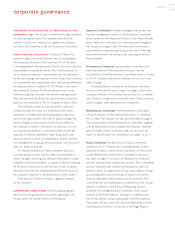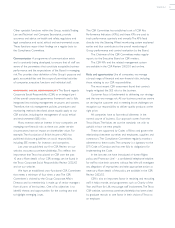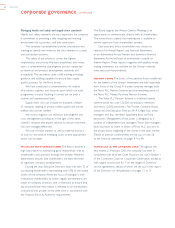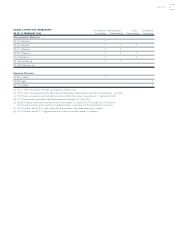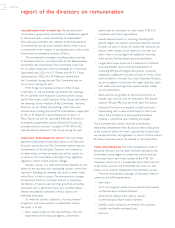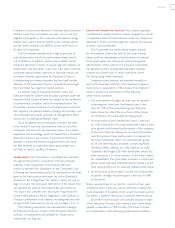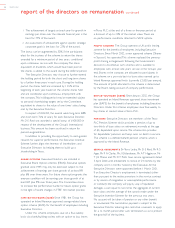Tesco 2003 Annual Report Download - page 6
Download and view the complete annual report
Please find page 6 of the 2003 Tesco annual report below. You can navigate through the pages in the report by either clicking on the pages listed below, or by using the keyword search tool below to find specific information within the annual report.
4TESCO PLC
FINANCIAL RISKS AND TREASURY MANAGEMENT
The treasury function is mandated by the Board
to manage the financial risks that arise in relation
to underlying business needs.The Board establishes
the function’s policies and operating parameters
and routinely reviews its activities, which are also
subject to regular audit.The function does not
operate as a profit centre and the undertaking
of speculative transactions is not permitted.
The main financial risks faced by the Group
relate to the availability of funds to meet business
needs, the risk of default by counterparties to
financial transactions (credit risk), and fluctuations
in interest and foreign exchange rates. These risks
are managed as described below. The balance sheet
positions at 22 February 2003 are representative
of the positions throughout the year.
FUNDING AND LIQUIDITY The Group finances
its operations by a combination of retained profits,
long and medium-term debt capital market issues,
commercial paper, bank borrowings and leases.
The objective is to ensure continuity of funding.
The policy is to smooth the debt maturity profile,
to arrange funding ahead of requirements and
to maintain sufficient undrawn committed bank
facilities and a strong credit rating so that maturing
debt may be refinanced as it falls due.
The Group’s long-term credit rating from
Moody’s was reduced from Aa3 to A1 during the
year, following the increase in debt which resulted
from the acquisition of HIT. An additional credit
rating from Standard & Poor’s of A+ was introduced.
New funding of £2,002m was arranged including
net new committed bank facilities of £347m and
medium-term notes of £1,385m maturing between
2008 and 2033. At the year end, net debt was
£4,737m (2002 – £3,560m) and the average
debt maturity was nine years (2002 – six years).
INTEREST RATE RISK MANAGEMENT The
objective is to limit our exposure to increases in
interest rates. Forward rate agreements, interest
rate swaps, caps and collars are used to achieve
the desired mix of fixed and floating rate debt.
The policy is to fix or cap a minimum of 40% of
actual and projected debt interest costs. Forward
start interest rate swaps and forward rate
agreements are used to manage projected debt
interest costs where appropriate. At the year end
£2.6bn, 55% of net debt was in fixed rate form
(2002 – £1.7bn, 46%) with a further £135m, 3% of
net debt, collared as detailed in note 20. Fixed rate
debt includes £427m of funding linked to the Retail
Price Index (2002 – £372m). This debt reduces
interest risk by diversifying our funding portfolio.
The balance of our debt is in floating rate form.
The average rate of interest paid during the
year was 5.7% (2002 – 6.3%). A 1% rise in UK
interest rates would reduce profit before tax by
less than 1%. Changes in interest rates in other
currencies would have no significant impact on
Group profits.
FOREIGN CURRENCY RISK MANAGEMENT
Our principal objective is to reduce the risk to
short-term profits of exchange rate volatility.
Transactional currency exposures that could
significantly impact the profit and loss account are
hedged, typically using forward purchases or sales
of foreign currencies. We translate overseas profits
into sterling at average exchange rates which we
do not seek to hedge. We hedge the balance
sheet by borrowing (either directly or via foreign
exchange transactions) in matching currencies
where this is cost effective. Our objectives are to
maintain a low cost of borrowing and retain some
potential for currency-related appreciation while
partially hedging against currency depreciation.
During the year currency movements had
minimal impact on profits and increased the net
value of the Group’s overseas assets by £22m
(2002 – £12m increase). At the year end forward
foreign currency purchases equivalent to £240m
were outstanding (2002 – £247m). See note 20.
CREDIT RISK The objective is to reduce the risk
of loss arising from default by parties to financial
transactions. The risk is managed by spreading
financial transactions across an approved list of
counterparties of high credit quality. The Group’s
positions with these counterparties and their
credit ratings are routinely monitored.
99 00 01 0302
NUMBER OF INTERNATIONAL
HYPERMARKETS
152
102102
6868
3838
2222
INTERNATIONAL
UNDERLYING OPERATING
PROFIT
£m
212
119119
7474
5050
4646
99 00 01 02 03
TESCO PERSONAL FINANCE
PRE-TAX PROFIT/(LOSS)
POST MINORITY INTEREST
£m
96
4040
66
((88))
00
((2828))
99 01 02 03
operating and financial review continued


